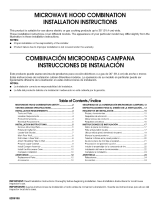
i_'_J_'!iC_ii_:CiLb:!:i?_C;iiiil)C_ii'_,_i!i!!?C:iii:%:3_!i_:ii%_!i:_iiO,ii¸_
El horno de microondas debera instalarse come minimo sobre
1 pie derecho de pared, preferentemente 2, usando un minimo de
1 tirafondo, preferentemente 2 o mas.
1. Con la cinta de medir, ubique y marque claramente la linea
central vertical de la abertura.
A. Lfnea central
2. Con las lengQetas de soporte mirando hacia adelante (vea las
ilustraciones en "Posibles configuraciones de los pies
derechos de pared" en la secci6n "Ubique el(los) pie(s)
derecho(s) de pared"), alinee la placa de montaje a la linea
central en la pared, asegurandose de que este nivelada y de
que la parte superior de la placa de montaje este contra el
extreme inferior del gabinete superior.
NOTA: Si el extremo frontal del gabinete superior esta mas bajo
que el extremo posterior, baje la placa de montaje para que la
parte superior quede nivelada con el extreme frontal del gabinete.
_! ..................D
A. Pared posterior
B. Placa de montaje
C. La parte superior de la placa de montaje deberb
alinearse con el extremo frontal del gabinete.
D. Extremo frontal del gabinete superior
3. Sosteniendo la placa de montaje en su lugar, marque los 4
orificios de esquina.
4. Ubique la(s) linea(s) central(es) de los pies derechos de la
pared marcadas en el paso 2 de "Ubique el(los) pie(s)
derecho(s) de pared", y marque per Io menos 1,
preferentemente 2 o mas, orificio(s) a traves de la placa de
montaje, Io mas cercano a la(s) linea(s) central(es). Vea las
figuras 1, 2 y/o 3 en "Posibles configuraciones de los pies
derechos de pared" en la secci6n "Ubique el(los) pie(s)
derecho(s) de pared". Los orificios ennegrecidos en las Areas
sombreadas son las ubicaciones ideales para los orificios.
5. Deje a un lado la placa de montaje.
Solamente para la instalacibn con ventilacibn en la
pared
I t
4" (10,2 cm)
6" (15,2 cm)
f lom, I
6" (15,2 cm)
6. Marque la linea central de 3/8" (1 cm) hacia abajo desde el
extreme inferior del gabinete superior.
7. Usando una cinta de medir, mida hacia afuera 6" (15,2 cm) a
ambos lados de la linea central y marque.
8. Mida hacia abajo 4" (10,2 cm) desde la mama que hizo en el
paso 6 y marque.
9. Trace con una regla 2 lineas niveladas horizontales atraves de
las mamas que hizo en los pasos 6 y 8.
10. Trace las 2 lineas verticales a plomo hacia abajo desde las
marcas hechas en el paso.7 hasta completar el rectangulo de
12" x 4" (30,5 x 10,2 cm). Esta es el Area de recorte de la
ventilaci6n.
11. Corte un orificio de 3/4" (19 mm) en una esquina del Area de
corte.
12. Corte el Area de corte de la ventilaci6n con una sierra
caladora.
Ademas de instalar la placa de montaje en al menos 1 pie
derecho de pared, la placa debe sujetarse a la pared en los
4 orificios de esquina. Si los orificios no estan sobre los pies
derechos de pared, use cuatro pernos de 1/4-20 x 3" con tuercas
de ajuste; si 2 orificios estan sobre los pies derechos de pared,
use 2 tirafondos por cada uno y pernos de 1/4-20 x 3" con
tuercas de ajuste; o si los 4 orificios se encuentran sobre los pies
derechos de pared, use 4 tirafondos. A continuaci6n se incluyen 3
configuraciones de instalaci6n.
Instalacibn sin pies derechos de pared en los orificios de
esquina (figuras I & 2)
1. Taladre orificios de 3/4" (19 mm) a traves de la pared en los
4 orificios de esquina que se marcaron en el paso 3 de
"Marcar la pared posterior".
2. Taladre orificio(s) de 3/16" (5 mm) en el(los) pie(s) derecho(s)
de pared en los orificio(s) que se marcaron en el paso 4 de
"Marcar la pared posterior". Vea las figuras 1y 2 en "Posibles
configuraciones de los pies derechos de pared" en la secci6n
"Ubique el(los) pie(s) derecho(s) de pared".
Instalacibn para un pie derecho de pared en dos oriflcios
de esquina (figura 3)
1. Taladre orificios de 3/16" (5 mm) atraves del pie derecho de
pared en los 2 orificios de esquina que se marcaron en el paso
3 de "Marcar la pared posterior".
2. Si instala sobre un segundo pie derecho de pared, taladre
orificio(s) de 3/16" (5 mm) en el pie derecho de pared en los
orificios que se marcaron en el paso 4 de "Marcar la pared
posterior". Vea la figura 3 en "Posibles configuraciones de los
pies derechos de pared" en la secci6n "Ubique el(los) pie(s)
derecho(s) de pared".
3. Taladre orificios de 3/4" (19 mm) a traves de la pared en los
otros 2 orificios de esquina.
20




















